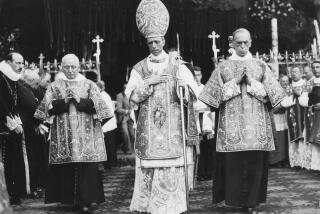U.N. archives on Nazi war criminals open to public at Holocaust museum
- Share via
After the end of World War II, investigations into former Nazis and other war criminals were detailed in hundreds of thousands of records that were unavailable to the public for about 70 years — files that finally became accessible this week at the U.S. Holocaust Memorial Museum in Washington.
The United Nations War Crimes Commission records include about 370,000 pages of documents collected between 1943 and 1949 about alleged Nazi war criminals and the charges filed against them, including meeting minutes, reports, correspondence, trial transcripts and microfilm images, museum officials announced Thursday.
Paul Shapiro, director of the Mandel Center for Advanced Holocaust Studies at the museum, said researchers would be able to examine the Holocaust through a trove of new digitized documents that included information about top Nazi leaders to lesser-known episodes such as the mass deportation and killing of Jews in Macedonia by Bulgarian forces.
“Often we only think about the Nazi leadership in Germany,” Shapiro said. “But here you see the degree of local collaboration and complicity that actually made the murder of 6 million Jews and the murder of the good part of the Roma population in Europe possible.”
Although investigators and historians have long known about the information in the documents, the public was unable to access the records. Those wishing to view the archive in the United States previously required the approval of the American ambassador to the United Nations and the U.N. secretary-general. Those who were allowed to view the material could not take notes.
The records include information about Adolf Hitler, cited for “murder and mass murder in concentration camps”; Heinrich Himmler, chief of the Gestapo and the SS and the orchestrator of the “final solution”; and Josef Mengele, the Auschwitz doctor known for his macabre experiments on prisoners. The files also include documents on lesser-known criminals.
Shapiro said the records revealed that many collaborators and perpetrators were never brought to justice.
“The detail in these records is really at the ground level and excruciating,” he said. “What one human being was able to do to another defenseless human being on a street corner of a town in the most crude way with a stick, with a shovel — simply because they knew they wouldn’t be punished for killing a Jew — is astonishing.”
Shapiro noted that the records included allegations against Kurt Waldheim, who served as U.N. secretary-general and Austria’s president, but left the world stage in disgrace after his Nazi past was exposed. He died in 2007.
In 1987, Waldheim was put on the U.S. Justice Department’s “watch list” of people formally barred from entering the county. U.S. officials cited evidence that it said showed he had “assisted or otherwise participated” in the persecution of Allied prisoners, Yugoslav partisans, Jews and other civilians. The accusations were never proved. Waldheim was never put on trial for war crimes and denied any wrongdoing.
The documents contain one individual’s testimony: “I remember certain persons having been murdered at Sarajevo in November 1944. They were executed according to the order given by Waldheim.”
“The fact that you have this from someone like a Waldheim, who was part of the U.N. and faced no consequence, is so striking,” Shapiro said.
Shapiro said the museum had received many inquiries about viewing the digital archives.
“These records are a reminder that human beings, all human beings, have the capacity to do terrible things,” Shapiro said. “From an educational perspective that’s important for us to remember.”
Follow @msrikris for the latest national news.
More to Read
Sign up for Essential California
The most important California stories and recommendations in your inbox every morning.
You may occasionally receive promotional content from the Los Angeles Times.










